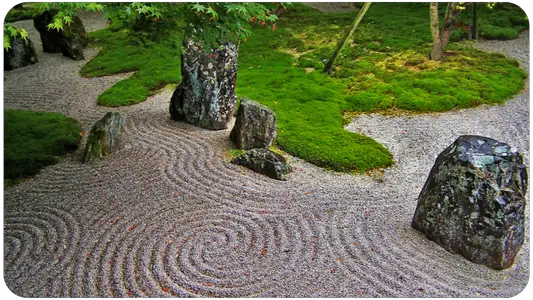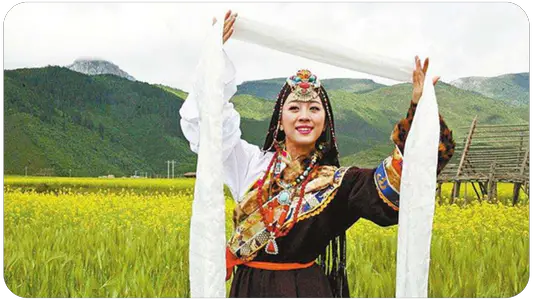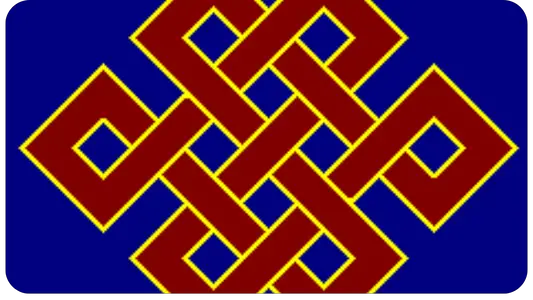Bodhisattva (Sanskrit: बोधिसत्त्व (devanāgarī), IAST: bodhisattva; Pali: bodhisatta; traditional Chinese: 菩薩; simplified Chinese: 菩萨; pinyin: púsà; Japanese: 菩薩 (bosatsu); Thai: พระโพธิสัตว์; Korean: 보살 (bosal (hanja: 菩薩));
Tibetan: changchub sempa Tibetan: བྱང་ཆུབ་སེམས་དཔའ།, Wylie: byang-chub sems-dpa'; Vietnamese: Bồ Tát (菩薩)) from sattva "being," bodhi "awakening," is a Sanskrit term that refers in Hinayana Buddhism to a Buddha before the Buddha has attained enlightenment.
In Mahayana Buddhism, it refers to one who has vowed to follow the path indicated by Shakyamuni Buddha, has taken refuge in the three jewels (Buddha, Dharma, and Sangha), and strictly observes the disciplines intended for bodhisattvas, in order to first help other sentient beings to awaken, delaying one's own liberation out of compassion.
According to the Avataṃsaka sūtra, there are fifty-two levels (or stages of training) of bodhisattvas: ten degrees of faith, ten degrees of abode, ten degrees of practice, ten degrees of merit transfer, ten lands, correct and equivalent awakening, and marvelous awakening.
At the beginning are the novices who learn the theories by practicing them, they have to train for three great kalpas according to the Mahāyāna to become buddhas, and at the end of the path are the great bodhisattvas such as Avalokiteshvara and Manjushri who, having already been buddhas in the past, return to our world in the role of a bodhisattva to facilitate the progress and awakening of those who willingly want to.
Birth of the Bodhisattva
Early Buddhism knew of the four noble beings, four stages of advancement on the path to enlightenment, the last of which is the arhant (or arhat), which must be attained to reach nirvana.
Early on, according to the history of Buddhist councils, disciples referred to collectively as the "great assembly" (mahāsanghika) challenged the quality of arhants, pointing out that they still retained too many imperfections.
At the same time, the term bodhisattva, not clearly explained, appears in the Majjhima Nikaya, the Anguttara Nikaya and the Samyutta Nikaya, used exclusively by Gautama himself when referring to his previous existences or his stay in the Tushita paradise ("When I was a Bodhisattva...").
A passage in the Sutta Nipata gives a little more detail, indicating that this is a path that Gautama voluntarily embarked upon out of compassion.
The bodhisattva in the different currents
Theravada
In the Pali canon and commentaries, the Pali term bodhisatta is used to refer to Siddhartha Gautama before his awakening, as well as to his previous incarnations. The bodhisatta path is not mentioned as a higher ideal or an alternative to the arahant state (as it is in the Mahayana).
In the Buddhavamsa and Chariyapitaka, which mention the Buddhas who preceded Gautama, the bodhisattva state is presented in more detail as the path taken by all the Buddhas of the past; the bodhisattva vows to take this same path even as they were about to awaken.
For unlike other renunciants who are about to leave the cycle of rebirths (saṃsāra), the bodhisattva chooses to continue to perfect himself for countless eons in order to become a samyaksambuddha, the only being capable of resetting the wheel of the Dharma, and thus of contributing more than anyone else to universal salvation.
Nevertheless, as Walpola Rahula has pointed out, in theravāda the path of bodhisattva is only conceivable for exceptional beings.
These seem to have been identified with the rulers in the past, first in Sri Lanka, then from the seventh century onwards in Burma and Thailand. King Mahinda IV (956-972) of Sri Lanka even asserted that only a bodhisattva had the right to rule the kingdom.
This king should in principle brilliantly practice the four virtues of giving (dāna), morality (śīla), abstinence (samyama) and restraint (dama). The association of bodhisattvas with nobility is reflected in their clothing and finery as depicted in Indian iconography; Gautama himself was born a prince.
Very few practitioners of Theravāda Buddhism, therefore, have manifested their intention to become a bodhisattva; the only ones recognized by this stream are the Buddhas of the past and Gautama in their previous existences, as well as Maitreya, announced in the Lotus Sutra as a future Buddha by Gautama himself.
For theravāda practitioners, the goal of the bodhisattva is unrealistic for most people and it is more effective for each person to focus on his or her own salvation.
There is, however, a theravāda treatise devoted to the bodhisattva path: the Dharmapâla Treatise on the Paramis (a commentary on the Chariyapitaka of the Khuddaka Nikāya).
Within the Paleo canon, the Chariyapitaka itself is considered to be for bodhisattvas since it deals with the ten paramis. The term "mahâsattva" (great being) is used in these texts to refer to certain bodhisattvas.
Mahayana and Vajrayana
The philosophers Nāgārjuna, Asanga, and Chandrakīrti defined the mahāyāna as the path of the bodhisattva, as opposed to the hīnayāna, the path of the hearer (śrāvaka); the career of the bodhisattva is for them by far the best choice. In the mahāyāna and vajrayāna, everyone, even lay people, is encouraged to aim to become a bodhisattva and may take vows to that effect.
Sometimes revered as deities, bodhisattvas are numerous and play an important role in the practice and propagation of Buddhist law.
Even more accomplished than those of the Theravāda, they are beings of "wondrous goodness" who, having brought the practice of giving (dāna) and wisdom (prajñā) to perfection (pāramitā) over many existences, have transcended the duality of nirvana and samsara to remain active in the world and help all beings find their deliverance.
Practitioners of mahāyāna and vajrayāna often present their goal (to become a bodhisattva to save all beings) as more altruistic than that of therapvāda (to become an arhat and aspire only to one's own salvation).
Nichiren Buddhism
The "bodhisattvas emerged from the earth "(Bodhisattvas_of_the_Earth (en)), are typical and unique to the Lotus Sūtra, they are not mentioned in any other sūtra.
In chapter 15, "Arising from the Earth," the ground of the saha world (our world where beings live who are plagued by multiple sufferings they must "endure ") begins to "tremble and crack open. "
they appear in infinite numbers, all of them having been converted by the Buddha, who decrees, in chapter 217, their mission to protect both the text of the Lotus Sūtra and its practitioners in their work of propagation, especially "in the times that will follow its entry into extinction, " at the time of the End of the Law. Guiding this multitude, four of these bodhisattvas who came out of the earth stand out.
According to Nichiren, even if the Lotus Sūtra, like all the sūtras preceding it, became ineffective at the time of the End of the Law, "the Law of Nam-myōhō-renge-kyō, present in the depths of Chapter 16, 'Duration of the Life of the Thus-Come, will spread to bring benefit to all human beings. "
In announcing the manifestation of the bodhisattvas coming forth from the earth, Nichiren is thinking particularly of the mission of the bodhisattva Visistacaritra (en) (Jōgyo, Upper Conduct) with whom he will identify.
The path of the bodhisattva
Various texts describe the stages, called bhumi (lands, grounds, or inner worlds of a human being that express his or her different states of mind), that an aspiring bodhisattva must pass through in order to reach the state of Buddha.
The Budhavamsa of the Pali literature envisages a stage of preparation and then three major stages of several eons each.
In the Chinese world, Vasubandhu's Ten Lands Sutra describes the ten stages to the Buddha state, and the Gandavyuha Sutra fifty-two. Both are incorporated into the Avatamsaka Sutra, of which they constitute the Rùfǎjièpǐn section (《入法界品》).
The most common version is the ten stages, preceded by two preliminary phases of merit accumulation and preparation. Each of the first six stages is associated with a perfection (pāramitā) that must be mastered: generosity (dāna), virtue (śīla), patience (kşānti), effort (vīrya), meditation (dhyāna), and finally wisdom (prajñā).
At this stage, the bodhisattva transcends the difference between nirvana and samsara. He perfects in the seventh stage the gift of skillful means upaya kaushalya (upāya kauśalya pāramitā) giving him more effectiveness in his work as a guide to spiritual awakening.
In the eighth and ninth stages he practices the perfection of vow (praṇidhāna pāramitā) and that of strength (bala pāramitā), already possessing a dharmic body (dharmakāya) which enables him to save beings in different forms in different places. At the tenth stage he practices sapience (jñāna pāramitā) and then becomes buddha.
Bodhisattva vows
To become a buddha, arhat, or bodhisattva, one must have expressed a vow in a previous existence. Practitioners of the mahāyāna and vajrayāna commonly take bodhisattva vows. Specifically, they commit to a certain number of the many recommendations and prohibitions proposed by Buddhist ethics.
The number imposed depends on the traditions and the status of the practitioner; it is normally less important for laymen than for monks (bhikkhu) or nuns (bhikkhuni).
The rules that must not be broken or the spiritual benefits of engaging in this path will be lost for many lifetimes are called core vows (or root vows in vajrayāna). These are supplemented by minor vows, the non-observance of which diminishes the merits, but to a lesser degree.
There are different lists of these with many commonalities, especially with regard to the main rules, the first ten of which are almost identical to the general precepts of Buddhism. Secondary rules for lay practitioners may be culturally specific, such as the prohibition of silkworm farming in China.
The formulation of the vows is inspired by various texts, among which we can cite:
The Brahmā Net Sutra, (sk. Brahmājālasūtra, ch. Fànwǎng jīng 《梵網經》) translated into Chinese by Kumarajiva (Kumārajīva) around 400, which contains a list of ten major and forty-eight minor vows, influential in Sino-Japanese Buddhism;
The sūtras mentioning the vows of famous bodhisattvas such as Ksitigarbha (Dizangwang Vow Sutra 《地藏菩薩本願經》), Samantabhadra (Avatamsaka Sutra, ch. Huáyánjīng 《華嚴經》) or the future Amitabha (Great Sukhāvatī-vyūha Sūtra 《無量壽經》);
The Mahāparinirvāna sūtra (《大般涅槃經》), the Bodhisattva Land Holding Sutra (sk. Bodhisattvabhūmidharasūtra, ch. Púsà dìchí jīng 《菩薩地持經》), the Bodhisattva Gemstone Necklace Sutra (ch. Púsà yīngluò jīng 《菩薩瓔珞經》) and the Sutra of Disciplines for Lay Buddhists, (sk. Upāsakaśīlasūtra, ch. Yōupósài jièjīng 《優婆塞戒經》) .
The Bodhisattvabhūmi, written around 300 by Asanga, whose eighteen root vows and forty-six minor vows are still in force in the Gelugpa and Kagyupa traditions of Tibetan Buddhism;
As an example, the ten major vows of the Brahmā Net Sutra are:
Do not kill;
Do not steal;
Do not commit the adulterous sexual act;
Do not distort the truth ;
Not to sell alcohol ;
Not to speak about the faults of Buddhists;
Do not boast or speak ill of others;
Not to be stingy with wealth or teaching;
Not to be angry or refuse the excuses of others;
Not blaspheming the Three Jewels (Buddha, Dharma and Sangha).
In the Chán and Zen streams, Buddhists often take the following Four Incommensurable Vows (Sìhóngshìyuàn 四弘誓願):
I vow to deliver all beings even though they are innumerable, (Zhòngshēng wúbiān shìyuàn dù 众生无边誓愿度);
I vow to eliminate all misguidance although it is incalculable, (Fánnǎo wújìn shìyuàn duàn 烦恼无尽誓愿断);
I vow to study all the teachings, though they are unlimited, (Fǎnmén wúliàng shìyuàn xué 法门无量誓愿学) ;
I vow to attain the state of the Buddha although it is incomparable, (Fódào wúshàng shìyuàn chéng 佛道无上誓愿成).
Bodhisattva vows were very popular in China from the Song onwards. They could indeed be taken by laymen or people kept away from monastic life by the vinaya, such as "hermaphrodites, people who were too sensual, gods and demons ".
It was thought that, through the precepts of the bodhisattva, the Mahyanna pantheon made it possible to free oneself from bad karma more quickly and more effectively than the less effective Hinayana techniques.
A Chinese commentary specifies that the Mahyanna pantheon is the most effective way to free oneself from bad karma. A Chinese commentary states that the precepts of the bodhisattva "instantly cleanse bad karma from which one repents, unlike the sravakanist precepts which involve definite steps".
Main Bodhisattvas
A real cult is paid to them, sometimes extending beyond the strictly Buddhist domain, particularly in China where four of them (Manjushri, Kshitigarbha, Samantabhadra and Avalokiteshvara) have a dual nature of bodhisattva and deity of popular religion.
The earthly places where they are reputed to have attained enlightenment, called bodhimandas, often become pilgrimage goals, such as Bodh-Gaya where the bodhi tree is located, which are the four Buddhist mounts in China.
The Eight Great Bodhisattvas (aṣṭamahābodhisattva) often called mahâsattva in Sanskrit, particularly revered by practitioners of mahāyāna Buddhism are the following:
Manjushri, "Gentle and Noble," "With charming radiance." Always young, he carries the sword, with which he cuts through ignorance, and the sūtra of the Prajñāpāramitā. He represents the qualities of wisdom and knowledge.
Samantabhadra "Entirely Excellent," "Auspicious," he represents the ultimate truth and is often associated with Mañjuśrī.
Avalokiteshvara (Chenrezig in Tibetan, Kannon in Japanese, Guanyin in Chinese), "One who looks down with compassion." He represents the compassion of Amitabha.
Mahasthamaprapta, "One who has acquired great strength," or Vajrapani, the "vajra-bearer," tantric form of Mahāsthāmaprāpta. Sometimes called the Lord of Secrets, he is the master of "skillful methods" (Upāya).
Akashagarbha "Matrix of space", "Basket of emptiness".
Kshitigarbha, "one who has the earth as his matrix," who has vowed to become Buddha only when hell is empty.
Sarvanivarana-Vishkambhin, "He who removes all obstacles".
Maitreya, "the friendly one", "the one who is loving-kind". His complexion is golden; he wears a crown or diadem, often with a stupa in the headdress. He holds a lotus or a bottle of ambrosia. According to the Lotus Sutra, Maitreya will become Buddha after Shakyamuni. On the other hand, he will not be the last Buddha.
Avalokiteśvara, Vajrapāni, and Mañjuśrī have a special patronage role in Tibet (riksum gonpo, "the Protectors of the Three Families").
In the literature
Colin Thubron describes bodhisattvas in his travelogue, The Shadow of the Silk Road, as "...those blessed beings who delayed their entry into nirvana in order to save others... "
Iconography
Historical bodhisattvas often look and carry themselves in a princely manner: adorned with jewelry (thirteen ornaments in principle, including necklace, bracelets, earrings, belt..,), they wear the loincloth, the diadem, and sometimes the Brahmanic cord.
They are often represented seated, in the attitudes of "ease" or "royal relaxation" (one leg folded on the seat, the other hanging). A great finesse and a feminine appearance characterize them.
They often hold a lotus in their right hand. They have a high bun and the urna on the forehead. In their hairstyle, they can wear the effigy of the Jina (Buddha) of which they depend or are the emanation (Tantric Buddhism). Thus, Avalokiteshvara wears the effigy of Amitabha.





